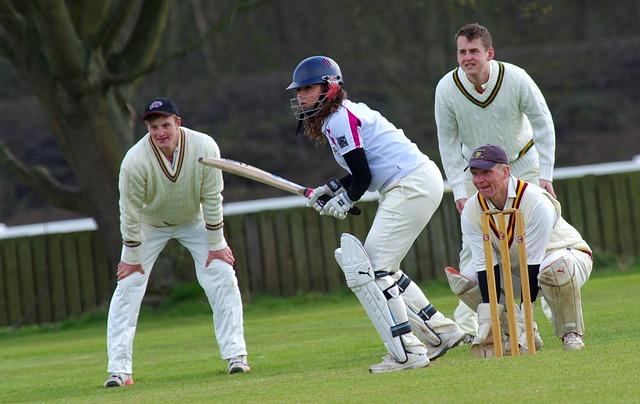- Advertisement -
India’s women’s cricket team has emerged as a formidable force on the global stage, signaling a broader shift in the nation’s sporting landscape. In recent years, their remarkable achievements have not only challenged traditional gender dynamics but also sparked a revolution in how cricket is perceived and supported across India. This article explores the pivotal moments and underlying factors behind India’s cricket revolution, highlighting how women’s victories are reshaping the game and inspiring a new generation of athletes.
Women’s Cricket Breakthrough Signals Shift in India’s Sporting Landscape
The rise of women’s cricket in India is more than just a sporting success; it reflects a broader transformation within the nation’s cultural fabric. The recent victories on international stages have sparked unprecedented interest among young girls and shifted public perception, challenging long-standing gender norms. Cricket, once predominantly a male domain, is now becoming a platform where women are asserting their presence with undeniable skill and confidence. This momentum is fostering greater investment in grassroots programs, professional leagues, and media coverage, encouraging a new generation to dream bigger and aim higher.
Key drivers behind this shift include:
- Enhanced training facilities catering exclusively to female athletes
- Increased sponsorship deals and televised matches highlighting women’s games
- Government initiatives promoting sports participation among women
- Role models emerging from historic tournament successes
- Community engagement programs breaking social stigmas around women in sport
| Year | Women’s International Wins | Grassroots Programs Launched | TV Audience Growth (%) |
|---|---|---|---|
| 2018 | 5 | 12 | 20% |
| 2019 | 7 | 18 | 35% |
| 2020 | 9 | 25 | 50% |
| 2021 | 12 | 30 | 65% |
Investment and Infrastructure Key to Sustaining Momentum in Indian Women’s Cricket
Securing a sustainable future for Indian women’s cricket hinges on robust investment and state-of-the-art infrastructure. While recent successes have spotlighted the talent pool, experts emphasize that without consistent funding, progress risks stagnation. Private sponsorships, government grants, and franchise support must converge to underwrite grassroots programs and elite training facilities tailored specifically for women athletes. Enhanced access to fitness experts, nutritionists, and sports psychologists will further professionalize the ecosystem, aligning India’s women cricketers with global standards.
Equally critical is the development of infrastructure that addresses both quantity and quality. From expanding the number of women-exclusive academies to upgrading stadiums with world-class amenities, such investments cultivate an environment where emerging players can thrive. The table below encapsulates current gaps versus ideal benchmarks in key infrastructure metrics for women’s cricket development:
| Infrastructure Aspect | Current Status | Ideal Benchmark |
|---|---|---|
| Dedicated Training Academies | 15 nationwide | 50+ nationwide |
| Access to Professional Coaching | Limited regional coverage | Pan-India availability |
| Stadiums with Women’s Facilities | 10 major venues | All top-tier stadiums equipped |
| Annual Grassroots Funding (INR) | Ōé╣10 crores | Ōé╣50+ crores |
- Strategic Partnerships: Collaboration between state boards, private leagues, and international bodies.
- Community Engagement: Programs encouraging girls’ participation from a young age.
- Technology Integration: Use of analytics and virtual training tools to enhance performance.
Empowering Future Generations Through Inclusive Policies and Grassroots Programs
At the heart of India’s cricketing ascent lies a strategic intertwining of inclusive policies with robust grassroots initiatives, designed to dismantle traditional barriers for women athletes. Governments and cricket boards have introduced schemes that emphasize access, training, and mentorship, ensuring that talent from diverse socio-economic backgrounds is nurtured from an early age. By integrating gender equity into sports infrastructure, the nation is not just expanding the talent pool but also challenging long-standing cultural norms that once limited female participation in competitive cricket.
Key pillars behind this transformation include:
- Community-driven cricket academies focused on rural and underserved areas
- Scholarship programs targeting young girls with promising athletic abilities
- Collaborations with NGOs to provide healthcare, nutrition, and psychological support
- Policy mandates for equal funding and media coverage in women’s cricket
These combined efforts are reflected in a striking ascent in both women’s cricket participation rates and international competitiveness, signaling a new era where opportunity and talent meet on equal footing.
| Year | Grassroots Programs Launched | Women Players Registered | International Match Wins |
|---|---|---|---|
| 2015 | 5 | 3,200 | 2 |
| 2018 | 12 | 8,750 | 7 |
| 2021 | 20 | 15,400 | 15 |
Concluding Remarks
As India’s women cricketers continue to break barriers and redefine the nation’s sporting landscape, their victories resonate far beyond the boundary ropes. The revolution unfolding on the pitch is not just about runs and wickets; it symbolizes a profound shift in societal attitudes and opportunities for women across India. With growing fan support, increased investment, and a momentum that shows no sign of slowing, the rise of India’s women cricket team marks a pivotal chapter in the country’s broader quest for gender equality in sports. The Lowy Institute’s spotlight on this transformation underscores how when women win, the entire nation progresses.
- Advertisement -


